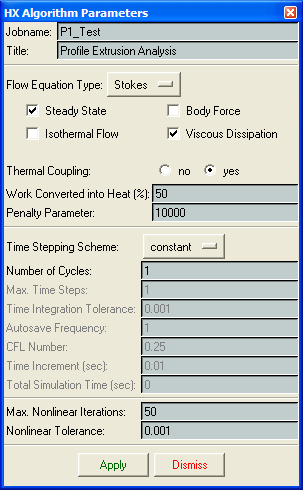Algorithm Parameters |

|

|

|

|
|
Algorithm Parameters |

|

|

|

|
The Algorithm Parameters option on the Solver menu contains the Jobname:, Title:, and other parameters associated with time stepping. The entries in this panel are automatically set by the program as it reads the problem data (material properties and boundary conditions). This panel also allows you to modify the parameters.
The Penalty Parameter option is used only for Augmented-Lagrange Scheme. This panel allows you to define the problem as isothermal or non-isothermal. For non-isothermal flows, activating the viscous dissipation terms in the energy equation of the model includes the effect of a conversion of mechanical energy into thermal energy.
When solving unsteady flow problems, you have the option of using either the Constant or Automatic time stepping schemes. The values specified nonlinear iterations and nonlinear tolerance are used only for Augmented-Lagrange Scheme.
When solving low Reynolds number flows, such as flow of polymer, the effect of advective terms is negligible. The Flow Equation Type: option enables you to solve either Stokes flow or Navier-Stokes flow equations. This option is active only for the Augmented-Lagrange Scheme.
The CFL (Courant-Friedrichs-Lewy) number is used when solving unsteady flows using the automatic time stepping scheme. The time step is by determined by the CFL number, the local element velocity, and dimensions.

The Algorithm Parameters panel